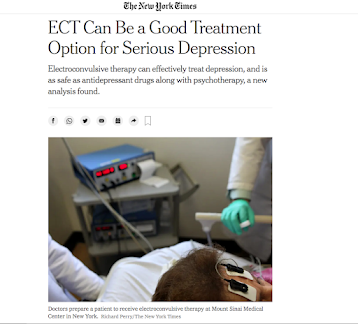NY Times Article on Canadian Study of Medical Safety of ECT
From the New York Times, September 21, 2021:
The link to the article is:
https://www.nytimes.com/2021/09/14/well/ect-therapy-depression.html
And from the "Comments":
ECT literally saved my Mother's life. She had stopped eating, was extremely paranoid, angry and slowly starving herself to death. I will be eternally grateful to her hospitalist who suggested that we try this treatment. While we were hesitant to prolong her suffering, the knowledge that our grandmother, her own mother had ECT more than 50 years ago and brought her back from the brink gave us the courage to try it. The results of my Mom's treatment was extraordinary--we were told it may take 5-6 treatments before she had interest in eating but after 1-2 treatments she was sending my sister out for Japanese noodles. After the completion of 12 treatments, she had totally returned to herself. She has no memory of those weeks in the hospital, which given the grave circumstances is a blessing. I am grateful that ECT is much more humane than when my grandmother received it. With this family history, I would not hesitate to make use of ECT myself should the need arise.
I’ve been a psychiatric nurse for more than eight years and I will tell you that ECT is a lifesaver for many patients. When you hear “electroshock” your brain is likely filled with images from One Flew Over the Cuckoos Nest or The Changeling. And yes, ECT used to be brutal, but now it is very brief and often has little to no long term side effects. I’ll never forget the first time I watched ECT save someone’s life. Their depression was so severe that they were catatonic. They lay unmoving, unresponsive, and trapped in their body. We had to turn and reposition their body every two hours to prevent bed sores, they had constant IV fluids as they could not eat or drink, and when we gave them Ativan (a benzo that is the first line treatment for catatonic) via a tiny oral syringe drip by drip into the sides of their cheek. They were dying slowly of their depression. And then we got the court order for ECT. Within days (ECT is given a max of three times a week) they began to open their eyes and speak. They began to be able to eat soft foods and drink fluids. By the end of their treatment they were walking, talking, laughing, smiling, and participating in unit activities and groups. It was the most profound case I have seen, but I’ve seen hundreds of other successes. I have people come to our facility specifically because they are desperate for ECT and it truly is a game changer. It is nothing like the horror it used to be and it saves lives.
I missed seeing this article when it appeared last month. (Please see also blog posts of August 2, 3, 2021 about the original Kaster et al. study). Colleagues Martin Jorgensen and Irving Reti are quoted in the NY Times piece. The 100 accompanying comments are predominantly negative, with the usual Sciontology-sounding tone, but there are also many very positive ones, including the above two.
The readership of the NY Times is so large that whenever ECT is discussed, it is an impactful moment for the field. I recommend reading the article, ~5 minutes.



Comments
Post a Comment